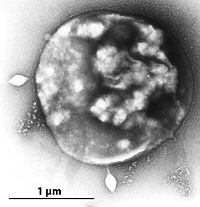From Wikipedia, the free encyclopedia
The three-domain system includes Eukarya (represented by the Australian green tree frog, left), Bacteria (represented by S. aureus, middle) and Archaea (represented by Sulfolobus, right).
In biological taxonomy, a domain (also superregnum, superkingdom, empire, or regio[citation needed]) is the highest taxonomic rank of organisms in the three-domain system of taxonomy designed by Carl Woese, an American microbiologist and biophysicist. According to the Woese system, introduced in 1990, the tree of life consists of three domains: Archaea (a term which Woese created), Bacteria, and Eukarya.[1] The first two are all prokaryotic microorganisms, or single-celled organisms whose cells have no nucleus. All life that has a nucleus and membrane-bound organelles, and most multi-cellular life, is included in the Eukarya.
Alternative classifications
Alternative classifications of life so far proposed include:
- The two-empire system or superdomain system, with top-level groupings of Prokaryota (or Monera) and Eukaryota.[2][3]
- The eocyte hypothesis, first proposed by James A. Lake et al. in 1984, which posits two domains (Bacteria and Archaea, with Eukarya included in Archaea).[4][5][6]
Exclusion of viruses
None of the three systems currently include non-cellular life. As of 2011 there is talk about Nucleocytoplasmic large DNA viruses possibly being a fourth branch domain of life, a view supported by researchers in 2012 who explain in their abstract:The discovery of giant viruses with genome and physical size comparable to cellular organisms, remnants of protein translation machinery and virus-specific parasites (virophages) have raised intriguing questions about their origin. Evidence advocates for their inclusion into global phylogenomic studies and their consideration as a distinct and ancient form of life. [...] Results call for a change in the way viruses are perceived. They likely represent a distinct form of life that either predated or coexisted with the last universal common ancestor (LUCA) and constitute a very crucial part of our planet's biosphere.[7]




